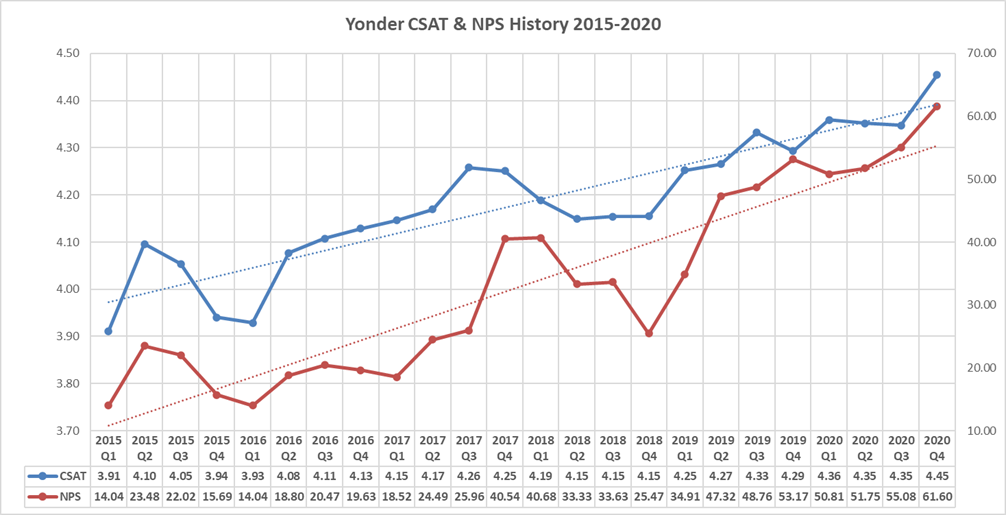Customer Satisfaction, why it is so important, and how we measure it
As a software development and consultancy company, we place a lot of value on how our customers perceive our services. So, we frequently measure customer satisfaction to help us with our direction as a company and our services. There are three strategic directions in which a company can deliver value: Operational Excellence, Customer Intimacy, and Product Leadership. Most companies choose one as their strategic pillar and make sure that the other two are up to the industry level. Very rarely will you find companies that can master two out of three directions.
Professional Services company and Customer Intimacy
Yonder is a Professional Services (PS) company in IT, and Customer Intimacy is our path to excellence. PS companies exist in many different industries, including finance, legal, marketing, IT, and virtually every type of consultant. These firms sell knowledge and expertise rather than tangible products. As a PS company, Yonder sells knowledge-intensive, complex, high-cost (effort, time), and unique services. We have our processes and best practices in place, but each client requires an outstanding service for their particular solution. By focusing on Customer Intimacy, we place our customers center stage. We continuously improve and tailor the services not only to meet but to exceed expectations. Customer Intimacy will create customer loyalty in the long term.
Understanding each customer
Each customer is unique and has particular needs – understanding this and keeping close to each customer is “the way” of performing in our business. From this derives the challenge of measuring the success of our efforts because “what gets measured gets done.” And the best way to measure is by simply asking the customers. It is a good and straightforward method, but it is not easy to do it well. That’s why there is so much research done in this area, and many concepts have been introduced over time: Customer Satisfaction, Net Promoter Score, Customer Engagement, Customer Happiness, etc.
From creating code to delivering business value
Back in 1993, when Yonder was established, much of the outsourcing market was capacity-based. This way of doing business had disadvantages, and Yonder evolved into a modern outsourcing company that takes responsibilities, thrives on delivering value to customers, and is results-oriented. We had to make sure each team was doing the right thing correctly, and all team members understood the clients’ challenges and needs. So, we had to measure customer feedback, and we have been measuring Customer Satisfaction since 2011 and NPS since 2014. In 2015, we implemented a new Customer Satisfaction process containing a better survey and transparent rules for the teams to follow up on the customers’ feedback. The same process is in work also today, with minor improvements – because the essential aspect about measuring Customer Satisfaction is to do it regularly and carefully analyze trends.
Not for show, but for Continuous Improvement
The theory says that simply asking the customers about their satisfaction shows that you care – but its higher benefit lies in the quality of the feedback we get and the lessons we learn from it. More simply put – the goal of measuring Customer Satisfaction is Continuous Improvement, which will benefit each customer and thus our company.
The most remarkable aspect of regularly measuring Customer Satisfaction is that it changed mentalities and attitudes – customers started to appreciate it, and Yonder employees are taking it very seriously. As a strategy, Customer Intimacy requires focus, a mindset of continuous improvement, and care for solving real problems. It means delivering what a customer really needs and working closely with each customer to identify the best solution for those needs.
Measuring the service delivery process and the outcome of the service
As such a survey is relevant for a PS company, we created ours in 2015 using a clear and compact form that we could repeat each quarter without it becoming annoying. As any survey expresses a perception, one could argue that the results are subjective or biased – and this might be true for a single answer. When we receive over 120 answers per quarter – there is no subjectiveness or bias anymore – the outcome is relevant to what customers think about our services. It gives clear indications of the areas that need improvements.
The survey must cover the essential areas of what Professional Services in IT are covering. Delivery of such services implies many encounters and interactions with the customer rather than a “one moment of truth.” Thus, we can identify two phases that influence the customer’s perception: the service delivery process and the outcome of the service. The service delivery process also has two defined categories:
- Perceived soft process quality (related to interaction: communication, cooperation, reliability, courtesy, understanding, etc.)
- Perceived hard process quality (related to technical: deliverables, physical resources, skills, etc.)
Yonder’s customer satisfaction survey contains specific questions in seven areas that cover both these categories:
- Reliability: “The team delivers according to upfront given commitments”
- Responsiveness: “The team is responsive (reacts quickly and constructively) in addressing your expressed needs as customer”
- Understanding: “The team understands your expectations”
- Communication: “The progress and the work performance of the team is transparent”
- Competence: “The team has a high level of technical excellence”
- Quality: “The team delivers according to mutually agreed expectations regarding quality”
- Objectives Reached: “Your business objectives set for the collaboration with the team in the evaluated period were reached”
Besides these seven questions, there is an Overall Satisfaction question, and the standard Recommendation question used to measure Net Promoter Score (NPS). We sent out all surveys on behalf of the team and the Delivery Manager working for the customer – and the feedback we receive goes directly to the team. Yonder has a well-defined process for following-up on the feedback, assuring our customers that we consider their input. The teams discuss the feedback, coming up with actions for improvements as suggested by customers. That is why it is important that our customers add comments to their ratings, as this gives us extra clarity on their expectations. This approach encourages a relation based on honest feedback and further collaboration on identifying the best actions to improve.
Value at a consolidated level
Overall results are analyzed and reported at Business Unit and company level. We carefully monitor the trends, and they result in specific corrective measures that we feel will give positive results in time. For example, feedback related to soft process quality has determined Yonder to invest in soft skills training (e.g., assertive communication, customer orientation, etc.). Other feedback may result in concrete actions at the team or Business Unit level – relating to improving the delivery process, the quality of service, or organizing technical training/workshops for team members.
Relating Customer Satisfaction or other monitored trends
Analyzing the data in time and monitoring the trends is even more relevant through correlations that can be made with other company indicators (loyalty of customers, revenues, etc.). We can say we have proven the theory by saying that Customer Satisfaction is positively correlated with Employee Satisfaction. We also measure Employee Satisfaction regularly, following the same principles of analyzing the feedback received. And the conclusion is clear: the customers of happier teams are happier about their collaboration with Yonder. Or a more satisfied customer makes for a happier team.
Net Promoter Score
Below is a graph showing the evolution of 2 indicators (Customer Satisfaction and NPS) in the last years as proof of mentality changes due to measuring Customer Satisfaction. It shows how we evolved, which is very relevant to us. And we see it as an encouragement and invitation to all Yonder customers to continue to provide us with their honest feedback. Participating with the survey assures clients that it will have a positive impact on them especially, and for the collaboration with Yonder in general:
If you would like to know more about setting up Customer Satisfaction in your company, get in touch with our Delivery Support Manager, Mircea Motogna.
STAY TUNED
Subscribe to our newsletter today and get regular updates on customer cases, blog posts, best practices and events.












